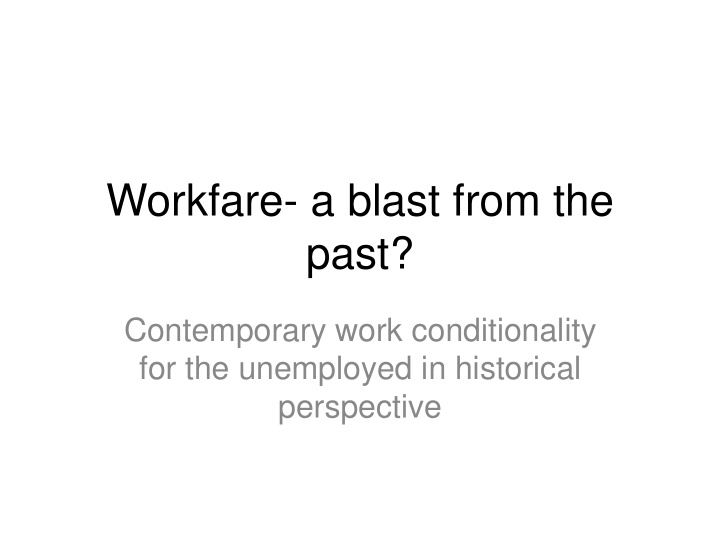



Workfare- a blast from the past? Contemporary work conditionality for the unemployed in historical perspective
Workfare in the new millenium • May 2011: the Mandatory Work Activity scheme requires JSA claimants to undertake a month's full time work. • August 2012: announced mandatory pilot scheme for young people (18-24 years) in London to take 13 week work placements. • Workfare seen as a radical departure in British labour market policy.
Heeding the lessons of history? • Policy makers and social theorists both paid little attention to the lessons of history. • Seek to make a distinctive contribution to the debate by undertaking historical review of workfare in inter-war Britain. • Both periods characterised by economic crisis (including near collapse of banking system) and ascendancy of economic liberalism .
'Secret History': British Labour Camps • 1929 - 1938 @ 190,000 men admitted to British labour camps (Croucher, 1987). • Targeted: young men demoralised by long- term unemployment (6 months in 'distressed areas') and whom were deemed a danger to the morale of ordinary training centres. • Most camps located in remote rural areas . • 1934 Unemployment Act made attendance compulsory but was never implemented: local unemployment officers coerced individuals to attend by threatening loss of benefit.
Experiences of the labour camps • Training: 12 week course of tough, manual labour (tree felling, breaking rocks) • 'They had us digging trenches. We would dig it down one day then the next day another group would fill it in'. (Mr Grant in Colledge, 1989: 19). • Atmosphere of the prison or barrack square : roll- calls, camp manager (military) and a team of 'gangers' worked directly with the men who were marched to work. • By late 1930s 1 in 3 quit or were discharged (poor food, bullying, suicides). Benefits stopped . • Just 1 in 5 trainees obtained work (Hannington, 1976).
Conclusions • MWA resuscitates a heritage of compelling the long-term unemployed to work for their benefit. • Workfare flourishes in times of economic crisis especially where economic liberalism and unemployment is seen as a behavioural problem . • Promoted as a means of developing the habits of work . But little evidence that individuals lost the habits of work: most returned to employment when economic conditions improved.
Conclusions (2) • Contemporary conceptualisations of workfare focus on its compulsive / punitive function. • Wacquant (2009) views it as part of 'double regulation of the poor' . Harsh social policies (workfare) and penal policies (prison-fare) work to control marginal populations. • A lack of historical focus: exaggeration of degree of change . Great Depression and economic liberalism led to brutal labour camps and burgeoning male prison population (Up 60% 1918-1933). • Welfare Reform Debate: 'He who controls the past controls the future. He who controls the present controls the past' (Orwell, 1949).
Recommend
More recommend